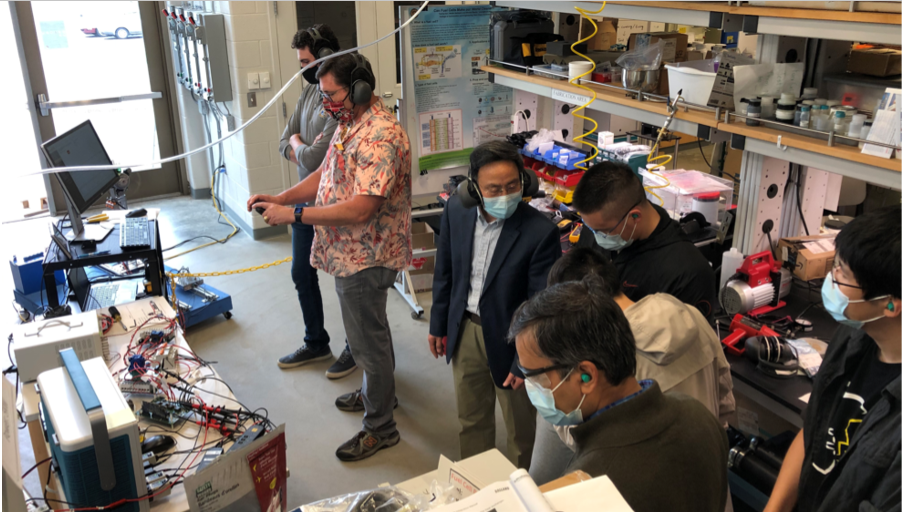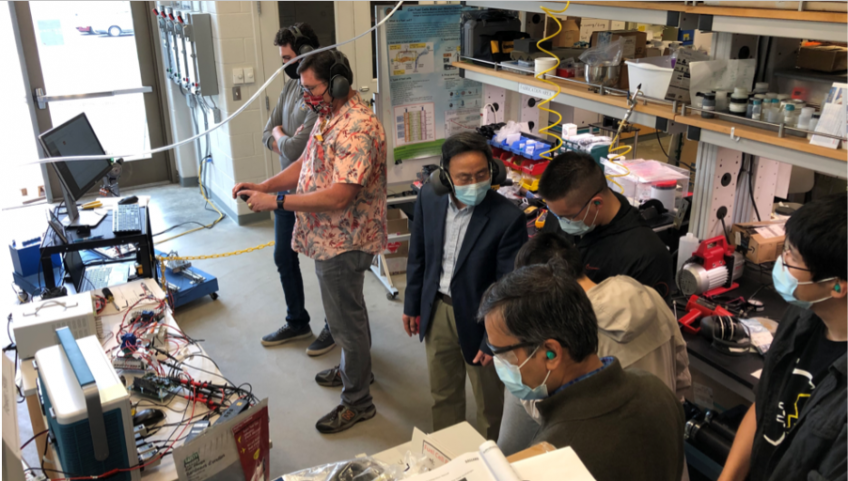Kent, Ohio- Kent State University developed a lightweight high-energy-density onboard power source that enables vertical takeoff and landing (VTOL) type aircraft to have potentially extended flight time and increased payload. The hybrid fuel cell battery/capacitor was developed through an Ohio Federal Research Network (OFRN)-funded project that took place from January 2020 to May 2022.
The project team includes Kent State University, University of Dayton Research Institute (UDRI), Case Western Reserve University, Wright State University, Event38 Unmanned Systems Inc., Air Force Research Laboratory (AFRL), NASA Glenn Research Center, and Army Research Laboratory.
Other types of batteries/technologies have previously been developed to prolong the flight time of drones. However, this OFRN-funded project led by Kent State University is the first hybrid fuel cell battery-capacitor specifically developed for commercial unmanned aerial vehicles (UAVs).
Dr. Yanhai Du, professor at the College of Aeronautics & Engineering and team leader and principal investigator at Kent State University's Fuel Cell Program, began the project by assessing the challenges. Current commercially available onboard power source technologies are either too heavy, noisy, or offer too short of a flight time to support UAV VTOL, 12-hour flight time, and quiet operations. Furthermore, the current flight time for drones is 20 to 30 minutes. Dr. Du and his team aimed to improve the weight capability, transient peak power demands, and flight endurance of UAVs.
“We rely on a fuel cell to extend the flight time and a battery pack and smart power management module to respond to the transient power needs of a drone simultaneously," said Dr. Du. "We demonstrated that UAVs integrated with our onboard hybrid fuel cell battery/capacitor could do much more than just carry and deliver a small camera or a pizza. With our technology, UAVs could carry much heavier weight and fly in a continuous operation in a lab setting for 12 hours. That's a long duration for a drone."
Potential hybrid fuel cell-battery/capacitor target users
The target users of this technology are the military and commercial users. The 12-hour flight time for UAVs demonstrated by Dr. Du’s team has huge implications for the military and commercial sectors.
“For example, Amazon and other commercial drones can fly for 20-30 minutes in a single flight. Normally, they deliver a package, then go back to their base to pick up the next package and then deliver it to another customer,” said Dr. Du. “If we create power cells that enable the drones to fly far and high, as well as carry several packages at a time, it could be more efficient and effective. So, our focus with this project is to increase flight time/distance and the weight that UAVs can carry.”
Other potential use cases for the technology include wildfire inspections and emergency response.
“An example in this situation would be, one could watch an interested area/region 24/7 by using two drones that can fly for 12 hours each. This can make the task very efficient without having to use helicopters and heavy personnel. On the commercial side, nowadays, a lot of inspectors use drones to do housing and bridge inspections. In California, inspectors might use drones for wildfire inspection. This new technology could potentially be used to deliver medical supplies and other emergency needs after disasters,” said Dr. Du.
The OFRN funded the Hybrid fuel cell-battery/capacitor project
The OFRN, an Ohio-wide R&D funding program managed by Parallax Advanced Research in collaboration with The Ohio State University and funded by the Ohio Department of Higher Education, played a vital role in both initial funding and successful completion of this project. As part of its mission, the OFRN fosters statewide university and industry research collaborations that meet the mission-critical needs of Ohio’s federal laboratories. Dr. Du’s project involved four universities and one industry partner working on a classified technology that required specific laboratory facilities. Along with support from Kent State University, OFRN offered help to set up and approve the plan for managing the team and specialized facilities.
“Without the OFRN’s support, we wouldn’t have gone this far. Apart from the critical monetary support, OFRN also helped us connect with federal agencies, like NASA Glenn Research Center, the Air Force Research Laboratory, and the Army Research Laboratory, and it confirmed that our effort aligned with the agencies’ missions,” said Dr. Du.
The OFRN funded $1,214,202 in the hybrid fuel cell battery/capacitor project. The funding comes from the OFRN’s $51.4 million investment provided by the State of Ohio. The project is one of 35 research projects that the OFRN has invested in since the program’s inception in 2014. These projects involve innovative collaboration from 21 universities and community colleges, and 97 industry partners throughout Ohio and have, in turn, attracted more than $211 million of follow-on funding from federal and corporate sponsors and resulted in the creation of 10 new Ohio companies across the state. The project awardees from OFRN-funding rounds 1 through 4 have also received Small Business Innovation Research and Technology Transfer (SBIR/STTR) funding totaling $17.6 million. From 2017 to 2021, the OFRN project awardees have won SBIR/STTR funding from various US Government agencies, including the US Air Force, AFWERX, Defense Health Agency, NASA, US Army, National Science Foundation, Department of Energy, and the US Navy.
Having met most of the goals of the project, Dr. Du’s team is now preparing for a flight demonstration of the technology. Dr. Du and his team are applying for additional federal and state funding awards to advance the hybrid fuel cell battery/capacitor technology. He’s also looking forward to working on commercialization efforts for the technology.
If you are an academic or industry innovator with promising ideas or intellectual property that you'd like to commercialize, are interested in collaborating with the Ohio Federal Research Network on research projects, or you need assistance and/or academic or industry partners in pursuit of federal funding, then we want to hear from you! Learn more about our R&D projects at Ohio Federal Research Network R&D Projects / Ohio Federal Research Network.
###
About Parallax Advanced Research
Parallax is a 501(c)(3) nonprofit that tackles global challenges by accelerating innovation and developing technology and solutions through strategic partnerships with government, industry, and academia across Ohio and the Nation. Together with academia, Parallax accelerates innovation that leads to breakthroughs. Together with the government, Parallax tackles critical global challenges and delivers new solutions. Together with industry, Parallax develops groundbreaking ideas and speeds them to market.
About the OFRN
The OFRN has the mission to stimulate Ohio’s innovation economy by building statewide university/industry research collaborations that meet the requirements of Ohio’s federal laboratories, resulting in the creation of technologies that drive job growth for the State of Ohio.




